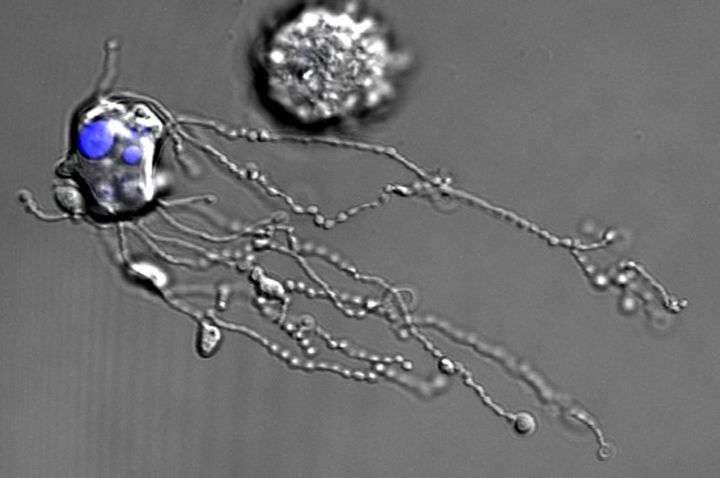Human cell death captured for first time

Scientists based at the La Trobe Institute of Molecular Science have discovered that some molecules which are central to the body's defence and immune system are ejected from inside the decomposing cell to form long beaded strings that can break off and are distributed through the body.
Lead researchers, Dr Ivan Poon and Georgia Atkin-Smith said until now scientists had thought the breakdown of dying cells was a random process. The team's work, published in the journal Nature Communications, has determined it is in fact highly regulated.
"The role of white blood cells is central to our body's innate immune system and much like fighter jet pilots are ejected from their downed aeroplane, we have discovered certain molecules are pushed free from the dying cell, while others are left behind in the 'wreckage' of the cell fragments," Dr Poon said.
"Proteins that are implicated in signal transfer, cell growth and maintenance all feature strongly in the beaded strings which are up to eight times longer than the host cell and that we have called 'beaded apoptopodia".
"It is the first time we have ever seen this take place and we now need to better understand the reasons behind this and the implications of this process of cell fragmentation.
"It could be that we've identified the mechanics of how dying white blood cells go about alerting neighbouring cells to the presence of disease or infection. Alternatively we may have discovered the transportation mechanism for a virus to infect other parts of the body.
"Programmed cell death occurs throughout life in essentially all tissues in the human body as part of the normal process of development and death, and the human body has innate mechanisms to clean up these fragments of dead cells.
"Specialised white blood cells called professional phagocytes are essential to this clean-up and we hope that by better understanding the mechanics of this, scientists can better harness the human body's own defence and healing mechanisms, leading to better health treatments and outcomes in the future.
"Importantly we've also discovered drugs that affect this process so, once we know more, we may be able to either suppress or enhance this action," he said.
More information: "A novel mechanism of generating extracellular vesicles during apoptosis via a beads-on-a-string membrane structure." Nature Communications 6, Article number: 7439 DOI: 10.1038/ncomms8439
Journal information: Nature Communications
Provided by La Trobe University




















